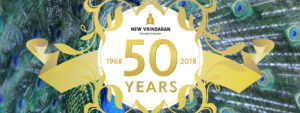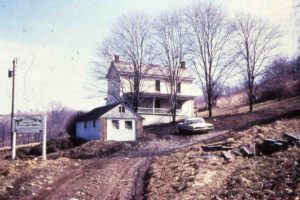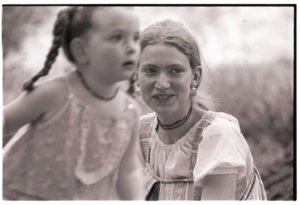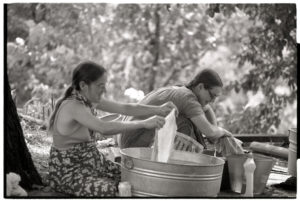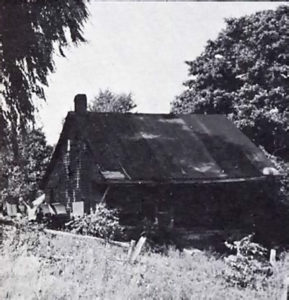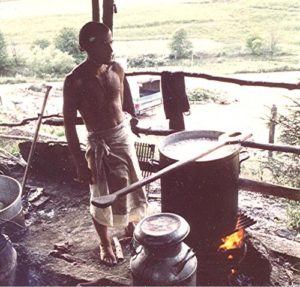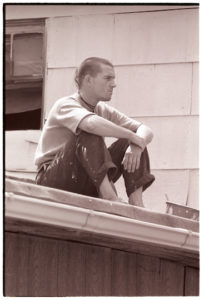NEW VRINDABAN DAYS – CHAPTER 5
NEW VRINDABAN DAYS
As New Vrindaban enters its 50th anniversary (1968 to 2018), I wrote this series of articles for the Brijabasi Spirit in an attempt to give the reader not only an “understanding,” but more importantly a “taste,” of what life in early New Vrindaban was like – through the stories of one devotee’s personal journey.
The title of the series, “New Vrindaban Days,” is in tribute to the wonderful book “Vrindaban Days: Memories of an Indian Holy Town” written by Howard Wheeler, Hayagriva Das. He was one of Srila Prabhupada’s first disciples, a co-founder of New Vrindaban, and, a great writer. As with Hayagriva’s book, this series focuses on a period of time in the 1970’s.
I would also like to acknowledge and thank Chaitanya Mangala Dasa, for spending untold hours assisting me in refining my writing for your reading pleasure.
I have been asked to describe certain aspects of early New Vrindaban Community life such as the nature of the austerities, what it was like for a new person coming here, cooking, anecdotes about particular devotees, etc.
I attempt to tell these stories in some semblance of a chronological order, beginning with my first meeting with devotees in 1968, leading to my arrival in New Vrindaban in late 1973 and carrying through to the official opening of Srila Prabhupada’s Palace in 1979.
In this particular article I do not tell a story but rather try to give a “stream of consciousness” breakdown of “the landscape” of New Vrindaban Community when I arrived to stay on January 17, 1974. I also suggest a list of the devotees that were in New Vrindaban when I arrived. I apologize for any names I have forgotten, or gotten wrong.
Please know I firmly believe without all these wonderful devotees there would be no “New Vrindaban Days” for any of us.
Advaitacharya Dasa
CHAPTER FIVE: THE NEW VRINDABAN LANDSCAPE – JANUARY 1974
BAHULABAN:
Main Deities: Sri Sri Radha Vrindaban Chandra
Location: State Road – McCreary’s Ridge Road
Temple Building: 100 Year old farm house purchased from the Coffield Family in 1971.
Ground Floor: Temple Room (a recent extension to the original farmhouse), Prasadam Room, Pujari Room, Tulasi Greenhouse (plexiglass build on to the side of the farmhouse), a primitive hand drawn “water well” with a black rubber bucket hanging on a rope. The well is partially covered with a concrete slab that contains a child’s handprint under which is the name “JUDY.” This was made by the daughter of Floyd Coffield, the person Bahulaban was purchased from. In 1974 Judy Coffield was likely in her twenties.
Second Floor: 3 Supply Rooms
Third Floor Attic: Brahmacarini living quarters
Original Coffield Barn: Fifty yards south directly across the patio from the temple – approximately 16 milking cows.
Swami’s Cabin: Kirtanananda Swami’s living quarters and “office” of the project, located just east, about twenty yards above the temple farmhouse, on the hillside.
Utility Buildings: Deity Kitchen (15 ft. block building), Incense Warehouse (15 ft. block building), Women’s Bathhouse (12 ft. block building), Corn Crib, Wood shed, Outhouse, Hilltop Pavilion (scene of Prabhupada’s Bhagavat Dharma Discourses – 1972),
Householder Heights: 2 wood buildings with small rooms for householder couples located 100 yards up the hill above the Swami’s cabin and the incense warehouse (1 building has 6 “apartments,” the other has 2).
Bahulaban residents when I arrived to stay on January 17, 1974:
Community President and GBC: Kirtanananda Swami.
Couples: Amburish and Vijaya, Kuladri and Kutila, Sudhanu and Lajjavati, Paramananda and Satyabhama, Adi Pati and Pracidevi, Vahna and Visvadhika, Daivata and Parayana, Gadadhara and Sarvesvari, Dulal Candra and Tarkik, Dharmatma and Lakhima, Yudisthira and Kamalavati, Yadunandana and Taruni, Bhidhan Candra and Ugrasena, Kirtiraja and Haripuja, Carney Ed and Bhaktin Lynn, Bhagavatananda and Yamini, Gajendra and Sucitra, Radha Kanta and Madhuryalilananda, Hayagriva and Shyama Dasi, Syamakunda and Girindra, Samba and Nandini Gokula, etc.
Brahmacharinis: Mahara, Rupa Ramesvari, Gunya Rupini, Isani, Kunjari, Kunti, Vajasana, Vajresvari, Mankumari, Vidya, Gomata, Radhabhavani, Carani, Hladini, Sudakari, Krsnamayi, Sukalina, Bhaktinidhi, etc.
Children:
Kuladri and Kutila’s daughter – Pritha
Kamalavati and Yudisthira son – Haladhara,
Hayagriva and Shama dasi sons – Samba and Haridas,
Kunti’s daughter – Kham (Karnamrta),
Radha Bavani’s daughter – Mallika,
Paramananda and Satyabhama’s sons – Premananda and Madhavendra Puri,
Daivata and Parayana’s daughter – Bhava,
Adi Pati and Pracidevi’s son – Krsnastami,
Yadunandana and Taruni’s son – Sanat Kumar,
Bhagavatananda and Yamini’s son – Bhakti,
Gajendra and Sucitra’s son – Purnima,
Girindra and Syamakunda’s son – Kiba Jaya (six days later daughter Vishaka is born).
Bahulaban is the hub of the New Vrindaban village. Everything is directed from the Swami’s cabin which sits on the hillside just above the temple building in the center of the patio. Every day after the morning program men gather in the cabin to figure out what projects will get priority that day.
Kuladri is regarded by most as the “Temple President” but at this time he is in Los Angeles learning to paint. At one point Radha Kanta is serving as the President in his absence. For a little bit it is Vipina Purandara. They may act as the temporary presidents but it is Kuladri’s wife, Kutila, who is everywhere and involved in all things. She is the personification of the surrender of the devotees of New Vrindaban. Although she has just had her first child she is back working in the Deity kitchen with her baby girl Pritha on her back the very next day. All the women look to her, and all the men admire and respect her.
There are very few school age children, so there is no formal school at this time (some had been sent to Dallas). The women in Bahulaban are involved everywhere. The brahmacharis walk down from the Vrindaban farm and work all over Bahulaban during the day. The barn is filled with cows who are milked twice daily by hand. The cooking needs done. The manure needs spread. The horse teams need worked. The firewood needs dragged in.
On the top of the largest hill they have broken ground for one of the Seven Temples: Govindaji. Srila Prabhupada had visited in 1972 and held a series of lectures called the Bhagavat Dharma Discourses in the pavilion on the top of the hill above Bahulaban. Sruti Kurti was in charge of the cooking for that festival and Sudhanu Das from NYC came to assist. Sudhanu was so taken by the place that he wound up staying.
In the side of the hill just above the central patio between the Swami’s cabin and the incense warehouse is an entrance to a cave they say they are going to hand dig through the mountain and out the other side about a mile away. At the time there is only about 20 feet dug out. In the back of the tunnel someone dug out a three foot deep hole that has filled in with spring water and serves as makeshift refrigeration.
Deep in the woods where the tunnel is predicted to come out of the hill is New Vrindaban’s “Syama Kunda.” In the original Vrindavan of India Syama Kunda is the sacred bathing place of Lord Krishna and the cowherd boys. In this area they say will be an amusement park celebrating the pastimes of Krishna.
There are rumors we are building a Palace for Srila Prabhupada to come and live in but in the realm of Bahulaban there is no sign of it.
There is no hot water and there won’t be for another couple of years. Everywhere you go and at all times it is cold and any signs of thawing are met with an ocean of mud everywhere. Providing firewood alone for the few buildings there are requires a full time staff of at least four men that are working on it all day long, seven days a week, outside in the weather. This includes cutting down the trees, hauling in the logs, cutting the logs to length, splitting the wood into the right sizes, and carting the wood to the different buildings.
Amburish heads up the cow barn and is joined in milking by devotees like Kuladri, Sudhanu, Samba and Cirantana as well as some the brahmacharis including Candramauli and Radhanath. All of the milking of is done by hand at this time.
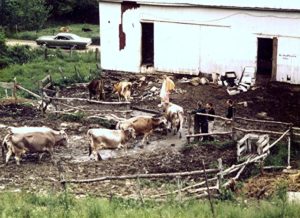
Bahulaban barn with Kirtanananda, Devakinandana, Taru, Cirantana & resident cows heading in for a milking.
Some of the couples that make up the solid core are Kuladri and Kutila, Amburish and Vijaya, Sudhanu and Lajjavati, and Bhagavatananda and Yamini. Isani does the jewelry, Vidya does the flowers and garlands, Sudhakari does the sewing, Ruparamesvari, Gunyarupini, Mankumari, Mahara, and a host of others work in all kinds of day to day activities designed to help us simply to survive, what to speak of expand. Babies are delivered by Adi Pati, a male devotee who lives a half mile back in the woods in a one room mud house with his wife Pracidevi and their young son, Krsnastami.
Because we are often harassed by guns shot into the air by passersby in the middle of the night, different pairs of men take times serving as night guards seven days a week.
VRINDABAN:
Main Deities: Sri Sri Radha Vrindaban Nath
Location: Three miles up an old logging road through the woods on a landlocked property.
Temple Building: 100+ year old small farmhouse secured by Hayagriva on a 99 year lease from the Rose family.
Ground Floor: Temple Room, Pujari Room
Second Floor: Brahmachari Ashram
Basement: Kitchen, Bathhouse
Out Buildings: Small Cow Barn (a few cows) – Pole Pavilion – Swami’s Log Cabin – 3 or 4 Brahmachari cabins- Hayagriva’s A-Frame.
Resident Brahmacharis: Radhanath, Param Brahma, Romaharsana, Bhakta Mark (Madhava Ghosh), Bhakta George (Jalakolahali), Bhakta Jim ( Jagat Trata), Papastaya, Chandra Mauli, Kasyapa, Kripacharya, Garga Rsi, Bhakta Burt (Bhavishat), Bhakta Ron (Gopinatha), Caidyasatru, Parasara, Bhakta Dennis (Damodar Pandit ), Somadas, Bhakta Atticus (Tapanacharya), Taru, Kiranasa, Nrsinghananda, Sridhara, Devakinandana, Murari Gupta, Krishna Sravana, Vasudhama, Cirantana, Gatravan, Vipina Purandara, Ajitananda & Haridhama.
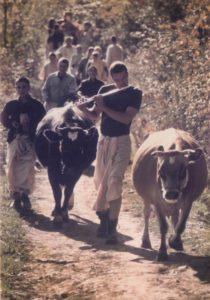
Gargarsi (playing flute) walking with Kaliya (ISKCON’s original cow) along the path to Vrindaban farmhouse.
It is the original New Vrindaban farm. It is the site where Srila Prabhupada spent a month at in 1969 and where he pointed out the future sites of New Vrindaban’s own Govardhan Hill and Kesi Ghat.
About thirty brahmacharis live in the ashram. The majority of them sleep on the floor in one room. There are cubbyhole shelves along the walls for the devotees to put their personal things in which don’t amount to much more than a change of clothes, a sleeping bag, one of Prabhupada’s books, and a toothbrush.
Param Brahma is the temple president. Radhanath is the pujari. Candramauli spends most of his time in the basement kitchen having his eyes burned out by wood smoke while he cooks the offerings and milk sweets for Sri Sri Radha Vrindaban Nath. Kasyapa is the horse driver and is considered by many to be the hardest worker in the community. Somadas is the carpenter. Bhakta Mark (soon to be initiated as Madhava Gosh) is doing the garden and is later to be called the best dancer in the movement by Tamal Krishna Goswami. Caidyasatru is the community avadhuta – he feeds goats, eats from the compost, and at times wears newspaper Brahmin underwear.
Taru is the scholar and the most infamous “Prasadam Addict” in the community. The older, wizened Romaharsana is the consummate woodsmen. Kripacharya is the blacksmith. Papastaya works in the garden. Bhakta Burt (soon to be Bhavishat) assists Romaharsana. Bhakta Dennis (soon to be Damodara Pandit) is starting the Brijabasi Spirit with visiting Sannyasi Paramahamsa Maharaja. Devotees like Bhakta George (soon to be Jalakolahali), Bhakta Jim (soon to be Jagat Trata), Haridhama, and others work at random other services. As hard as they work, they sankirtan even harder.
They are all young men. All working hard, eating little, and sleeping even less. Some are saintly and composed. Well, maybe one or two. And, the majority of the others are agitated out of their minds. Austerity, sense control, and deprivation interact to create an explosive combination. There is pressure on all sides. Other than Radhanath and Candramauli, all brahmacharis walk a muddy logging road the three miles through the dense woods every day to work at Bahulaban. They make the same walk back every evening. After the Sunday feast each week in Bahulaban the Swami and a few of the married men make the trip up the road with them to spend the night with Sri Sri Radha Vrindaban Nath.
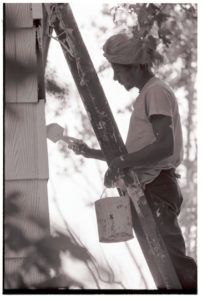
Radhanath Dasa painting the outside of the Madhuban Temple building (a decade later he became a Swami).
MADHUBAN:
Main Deities: Sri Sri Radha Madhava
Location: Second property purchased after the original Vrindaban farm in 1971. Almost directly east, across the valley from the Vrindaban farm and about three miles North, up the state road from Bahulaban.
Temple Building: 100 year old farmhouse
1st Floor: Temple Room, Kitchen
Out Buildings: Small tin roof shelter for cows and horses.
Prabhupada Houses: In the tree line about fifty yards from the temple farmhouse the devotees have begun building “Prabhupada Houses,” made of tamped clay. They are called the Prabhupada houses because it was a form of construction that Srila Prabhupada had suggested in a letter dated 07/27/1973. They consist of only one room about 12 ft. by 15 ft. and are meant to be housing for householders. Some devotees spend short periods of time trying to live in them but they don’t really last. Shyamakunda and Girendra’s daughter Visakha will be the first girl born in New Vrindaban and she will be born on January 23rd.
In the winter of 1974, only a few devotees inhabit Madhuban. The principal devotee there is Paramananda Das who is not only one of the original inhabitants of New Vrindaban, having arrived in the spring of 1969, but he and his wife Satyabhama are also two of the original devotees from 26 Second Avenue. Paramananda and Satyabhama have two sons, Premananda and Madhavendra Puri. Kuntidevi Dasi lives in Madhuban with her young daughter Kham (Karnamrita), along with a few others.
Paramananda is the acting head of the entire community’s farming, or the “plough,” department. There is only one old red tractor and three teams of horses. Paramananda is known by many of the local farmers who he travels to meet with to learn about farming in the rough hills of West Virginia. Sometime in the next year Paramananda, his family and a few friends will leave New Vrindaban to found Gita Nagari in Pennsylvania. After that Paramananda will also eventually become a Minister of Agriculture for the greater ISKCON.
About a mile further North past the Madhuban temple live the very austere Yudisthira Das along with his wife Kamalavati and their young son Haladhara. They are living off the land, farming with oxen, in a very small log cabin.
The primary activity at Madhuban is caring for the Deities, Sri Sri Radha Madhava.
TALAVAN:
There is no temple building in the part of the community called Talavan. Living in Talavan are a few more senior, independent devotees including Yadunandana and his wife Taruni.
NANDAGRAM:
There is no temple at this location. There is an old farmhouse and a shelter for a few oxen and cows. Nandagram is inhabited by the family of Hayagriva Das and Shyamadasi, along with their two children, Samba and Haridas. Besides the house, Hayagriva has a very small shelter down in the woods across from the house where goes to write and edit.
——————————————————
Did you miss any of the previous chapters? Click the links below to catch up:
Chapter 1: Every Journey Begins With a Single Step
Chapter 2: Srila Prabhupada – Jaya Radha Madhava
Chapter 3: Captured by the Beauty of Sri Sri Radha Vrindaban Chandra
Chapter 4: Fired Up – We Depend On Sri Sri Radha Vrindaban Chandra
Stay tuned for Chapter 6: In The Woods
